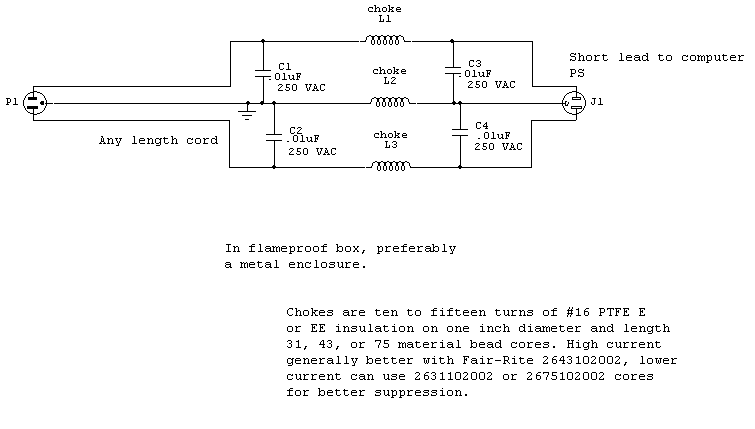|
Related Pages
Filters and Stubs
Low Pass Filter
There is some confusion about what filters do. Many think filters absorb
unwanted energy, converting unwanted energy to heat inside the filter. Another common thought is
filters route unwanted energy to ground, making unwanted signals vanish in the
equipment or station ground system.
Filters, unless they contain some form of diplexer, reflect unwanted signals
back toward the source.
Typical filters (and stubs) create a large impedance mismatch at the harmonic,
ideally an open or short, although some systems might work best with a certain
value and sign of reactance.
Let’s look at one
filter design in SPICE.
Inside the filter below:
RL1, 2, and 3 represent inductor losses.
RC1 and 2 represent capacitor losses.
Outside the filter:
L4, RL, and C3 represent a frequency-selective load tuned to 80 meters.
Rs is source resistance.

With the 80-meter low pass filter, on 3.6 MHz and 7.2 MHz for peak heat,
we have:
| Component |
3.6 MHz power |
7.2 MHz power |
3.6 MHz voltage |
7.2 MHz voltage |
| Rs |
50W |
70W |
50 volts |
76 volts |
| C1 |
30 milliwatts |
27 milliwatts |
70 volts |
35 volts |
| C2 |
30 milliwatts |
1 milliwatts |
70 volts |
6 volts |
| L1 |
170 milliwatts |
220 milliwatts |
|
|
| L2 |
340 milliwatts |
18 milliwatts |
|
|
| L3 |
170 milliwatts |
>>1 milliwatts |
|
|
| RL |
50 watts |
>70 mW |
50 volts |
~0 V |
3.6 MHz low pass filter, with capacitor input

| Component |
3.6 MHz power |
7.2 MHz power |
3.6 MHz voltage |
7.2 MHz voltage |
| Rs |
50W |
132W |
50 volts |
58 volts |
| C1 |
15 milliwatts |
80 milliwatts |
50 volts |
58 volts |
| C2 |
30 milliwatts |
5 milliwatts |
50 volts |
10 volts |
| C3 |
15 milliwatts |
0.5 milliwatts |
50 volts |
5 volts |
| L1 |
340 milliwatts |
80 milliwatts |
|
|
| L2 |
340 milliwatts |
4 milliwatts |
|
|
| RL |
50 watts |
150 mW |
50 volts |
~0 V |
The data above shows filters reflect harmonics back toward the source, through
mismatch. Filters generally do not absorb unwanted signals, nor do they route
harmonics to ground.
As with stubs, filters normally have sweet and sour spots along transmission
lines. The sweet spot is normally NOT directly at the output port of an
amplifier for high-frequency band harmonics for both filters and stubs, and is
more often very close to the antenna if it is placed near anything, yet we
normally place filters right at the amplifier. I believe the idea a stub
or filter needs to be near the transmitter comes from early-day TVI filters.
Power Mains Filter

|


